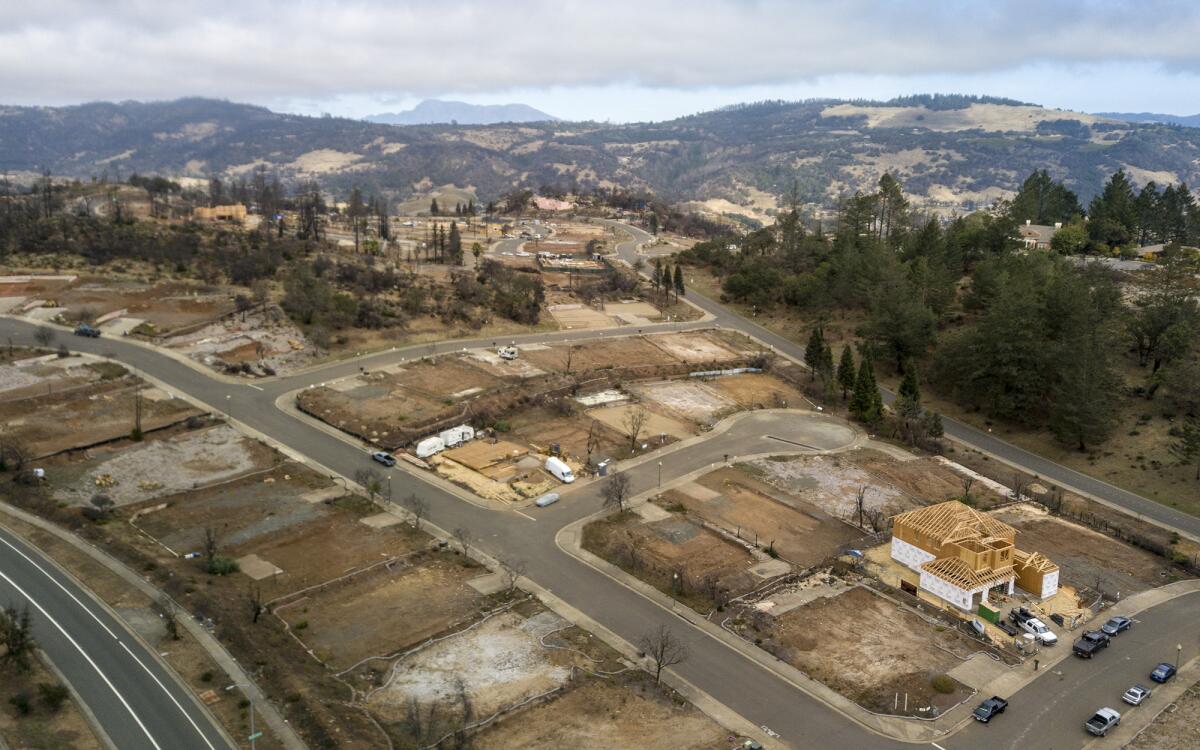Op-Ed: California’s wildfires revealed a fix for our housing crisis — if we’re willing to act

The destructive fires that roared through California over the last two years have displaced tens of thousands of people, creating a humanitarian crisis as well as a housing crisis. One of those fires provided valuable lessons on how to solve emergency housing shortages in the state — the Tubbs fire that ravaged the city of Santa Rosa and Sonoma County in 2017.
City and county officials treated the aftermath of the Tubbs fire as the crisis it was. In the months after the blaze, they implemented programs to expedite the rebuilding of thousands of homes. Santa Rosa reduced the fees the city levies on high-density, multifamily housing and on accessory dwelling units often called granny cottages. And instead of taking years to issue rebuilding permits, the city processed thousands each month. Sonoma County also waived some housing fees and opened a Resiliency Permit Center to speed up permitting for those dealing with fire damage.
Their approach inspired me to introduce Senate Bill 330, which I call the Housing Crisis Act of 2019. The bill would accelerate housing construction in the state during the next half-decade by slashing the time it takes for developers to get building permits, limiting fees on housing and barring local governments from reducing the number of homes that can be built.
While California’s statewide housing shortage was not caused by wildfire, it’s still a humanitarian crisis — one of our own making. The fact that we have failed to build enough housing to keep up with the state’s population and job growth has led to the highest rents and home ownership costs in the nation.
California now ranks 49th in the nation in housing units per capita. The extreme scarcity of housing has made renting or buying a home prohibitive for many. The median home price is more than $610,000, and 33 of the 50 U.S. cities with the highest rents are in California. Nearly a third of California renters spend more than half of their incomes on rent.
The housing crisis has also led to a crisis in homelessness. California is now home to a quarter of the nation’s homeless people. On any given night, about 130,000 people are living on our streets, a 10% increase since 2016. Nearly half of the homeless population lives in Los Angeles County.
SB 330 is based on the premise that much of the housing we need has already been planned for by our local communities. California cities and counties have approved zoning for 2.8 million new housing units, according to a 2019 report by UCLA Lewis Center for Regional Policy Studies. Under current zoning rules, Los Angeles County alone has the potential to build 567,040 new units.
But the housing is not being built. Almost 20% fewer residential building permits were approved in the first six months of 2019 compared with the same period a year ago. There are many reasons for the home-building slowdown, including soaring costs of construction and materials and labor shortages.
Recent studies have also pointed out two other problems: Cities and counties often levy burdensome fees that can reach $50,000 per unit on housing projects, and developers can face delays of up to four years after they submit their applications to build housing.
Local government fees on housing in California are three times the national average, according to a 2018 study by UC Berkeley’s Terner Center for Housing Innovation. A later Terner Center report also found that cities and counties often do not reveal the total amount of fees that housing project applicants must pay until months or years after a proposal is submitted, a problem that can threaten a project’s viability.
Earlier this year, a UC Berkeley Law School report examined how long it took for multi-unit housing projects to obtain approval in Los Angeles, Long Beach, Pasadena and Santa Monica over a three-year period. The time frames ranged from more than 10 months in Long Beach to more than 48 months in Santa Monica. Lengthy delays often kill housing projects because costs increase and projects no longer pencil out.
SB 330 is designed to help California communities swiftly build much of the housing the state needs without altering local zoning rules. Until 2025, cities and counties would have to slash the time it takes to process housing applications to no more than 90 days for most market-rate housing projects and to 60 days for affordable ones after a project application is deemed complete and it complies with local zoning rules. The bill also limits the number of public hearings on a project to five. In addition, cities and counties would be barred from hiking fees after the project applicant has submitted all preliminary required information.
For five years from the time the bill becomes law, urban areas throughout California would be prohibited from changing design standards for how housing should look, reducing the number of housing units allowed, establishing a cap on the number of people who can live in a community, or implementing a moratorium on new housing construction.
The bill also includes anti-displacement measures, including a ban on the demolition of affordable and rent-controlled units unless developers replace all of them and pay to rehouse tenants and offer them first right of return at the same rent.
SB 330 is scheduled to be heard by the Assembly Appropriations Committee on Friday. If approved in committee, it would go to the full Assembly for consideration next week.
Gov. Gavin Newsom has called for building 3.5 million new units of housing in California by 2025. The Housing Crisis Act would help us get there.
Sen. Nancy Skinner (D-Berkeley) is the California Senate majority whip.
More to Read
A cure for the common opinion
Get thought-provoking perspectives with our weekly newsletter.
You may occasionally receive promotional content from the Los Angeles Times.










